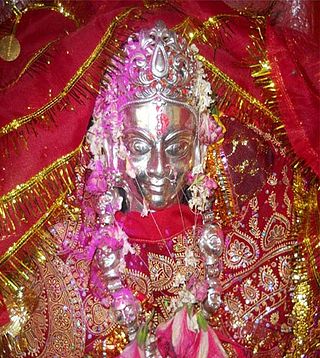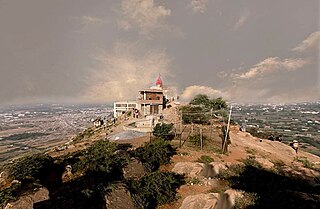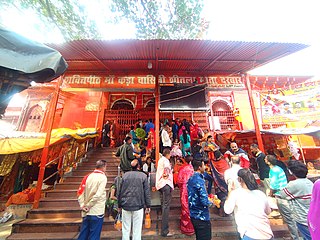
Virar is a coastal city in taluka Vasai and district of Palghar, in India's Maharashtra state. It is clubbed into Vasai-Virar city, administered by Vasai-Virar Municipal Corporation. It lies in south part of Palghar District in Vasai Taluka and north to the city of Mumbai. It is an important part of Palghar District because Palghar is the outermost part of northern side of Mumbai Metropolitan Region and comes under Police Jurisdiction of Mira-Bhayander, Vasai-Virar Police Commissionerate.

Kudargarh is a famous Hindu pilgrim centre situated in Surajpur District of the state of Chhattisgarh in India. It is 44 km from district headquarters of Surajpur connected by an all-weather road. The best time to visit is during Chaitra Navaratra . It is located on a hillock with approximately 890 steps. A very panoramic view from top on addition to the DARSHAN of deity.

Sheetalalit. '"coolness"', also spelled as Shitala and Seetla, is a Hindu goddess venerated primarily in North India. She is regarded to be an incarnation of the goddess Parvati. She is believed to cure poxes, sores, ghouls, pustules, and diseases, and most directly linked with the disease smallpox. Sheetala is worshipped on Tuesday Saptami and Ashtami, especially after Holi during the month of Chaitra. The celebration of the goddess Sheetala on the seventh and eighth day of the Hindu month is referred to as the Sheetala Saptami and Sheetala Asthami, respectively.

Saptashrungi or Saptashringi is a site of Hindu pilgrimage situated 60 kilometres (37 mi) from Nashik in Indian state of Maharashtra. According to Hindu traditions, the goddess Saptashrungi Nivasini dwells within the seven mountain peaks. It is located in Nanduri, Kalwan taluka, a small village near Nashik in India. The Marathas and some Hindu tribes worship the goddess from a long time and some worship as their kuldaivat. There are 510 steps to climb the gad. Devotees visit this place in large numbers every day. The temple is also known popularly as one of the "three and half Shakti Peethas" of Maharashtra. The temple is also one among the 51 Shakti Peethas located on the Indian subcontinent and is a location where one of Sati's limbs, her right arm is reported to have fallen. Its half shaktipeeth among three and half shaktipeeth of Maharashtra.

Chintpurni is a small town in the Una district of Himachal Pradesh about 40 km north of Una, not far from the border with the Indian state of Punjab. The elevation is about 977 meters. It is home to the Maa Chintpurni Temple which is a major pilgrimage site as one of the Shakti Peethas in India. The Hindu genealogy registers at Chintpurni, Himachal Pradesh are kept here. North of Chintpurni are the western Himalayas. Chintpurni lies within the much lower Shiwalik range.

Kaila Devi Temple is a Hindu temple situated in Kailadevi village of Karauli district, in the Indian state of Rajasthan.

The Shree Vajreshwari Yogini Devi Mandir is a Hindu temple dedicated to the goddess Vajreshwari, located in the town Vajreshwari, 75 km away from Mumbai. The town, earlier known as Vadvali, was renamed Vajreshwari in honour of the presiding deity of the temple.

Mata Mansa Devi is a Hindu temple dedicated to goddess Mansa Devi, a form of Shakti, in the Panchkula district of the Indian state of Haryana. The temple complex is spread of 100 acres (0.40 km2) of the Shivalik foothills in the village of Bilaspur, near Sector 13 of Chandigarh, and Panchkula, 10 km from Chandi Mandir, another noted Devi shrine in the region, both just outside Chandigarh.
Bijasan Mata Temple is one of the temples of the Hindu goddess Durga, situated in Indore District of Madhya Pradesh, India. This temple is built in the year 1760 by Shivaji Rao Holkar. This temple is visited by thousands of devotees during Navaratri.

Chandi Devi Temple, Haridwar is a Hindu temple dedicated to Goddess Chandi Devi in the holy city of Haridwar in the Uttarakhand state of India. The temple is situated atop the Neel Parvat on the Eastern summit of the Sivalik Hills, the southernmost mountain chain of the Himalayas. Chandi Devi Temple was built in 1929 by Suchat Singh in his reign as the King of Kashmir. However, the main murti of Chandi Devi at the temple is said to have been installed in the 8th century by Adi Shankaracharya, one of the greatest priests of Hindu religion. The temple also known as Neel Parvat Teerth is one of the Panch Tirth located within Haridwar.
Jawali is a town in Kangra District of Himachal Pradesh State in India.Old name of Jawali is Jawanwalashehar. Jawali is the second largest Assembly constituency in the state of Himachal Pradesh. It is located 250 km distance from its State Capital, Shimla and is located 50 km distance from its District headquarters Dharamshala.
Mata Sarthal Devi Mandir is a Hindu temple at Sarthal of Kishtwar district in India's Jammu and Kashmir which has an annual pilgrimage known as Sarthal Yatra.

The Sikri Mata Temple, officially known as the Shri Mahamaya Devi Temple, is a Hindu temple at Sikri Khurd village, Ghaziabad district, Uttar Pradesh, India. The temple was built in the 17th century by Jalim Giri Baba and his family, who belonged to the Goswami community of the village. Its administration was taken over from the descendants of Giri Baba by the gram panchayat in 1977. Dedicated to the goddess Sikri, who is believed to be an incarnation of Durga, the temple attracts large gatherings of visitors during the biannual festival of Navaratri. During the Chaitra month of Navaratri, marking the beginning of a new year on the Hindu calendar, a large historical fair is organised for nine days. The fair was cancelled in 2020 due to the COVID-19 pandemic for the first time since 1918. There is a banyan tree on the temple premises from which more than 130 revolutionaries were hanged to death during the Indian Rebellion of 1857.

Tungareshwar Temple is located in Vasai, Palghar District, Maharashtra, India. The temple is dedicated to the Hindu god Shiva, about 3 to 4 kilometres from the "Tungareshwar Entrance Gate", opens at morning 05:00 AM to 06:00 PM. This is one of the Lord Shiva Temple and also have Ram Kund on backside area. Alongside the Tungareshwar Temple, a small temple of Goddess "Khodiyaar Mataji". Being said about God and Goddess, Tungareshwar attracts devotees who visit both these temples at special occasions and festival seasons like "Khodiyar Jayanti" which comes in around February and "Maha Shivratri" in Shravana Months as Hindu calendar, falling between July and August every year. Bhandara takes place every year at the "Mahashivratri Festival" and every Monday at the Shravan month.

Savitri Mata Mandir or Savitri Temple is a Hindu temple of Goddess Savitri located in ratnagiri hill which is a popular pilgrimage site, Pushkar, Ajmer, Rajasthan, India. Savitri Mata Mandir is a hilltop Hindu temple. The temple is situated at an elevation of about 750 ft and a flight of 970 steps to Savitri temple, which is one of the most significant temple in India. Idols of both the wives of Lord Brahma named Savitri and Gayatri are established in this temple.

Mumbra Devi Temple is an old Hindu temple situated at the top of Parsik Hill in Mumbra, a suburb of Thane district, near Mumbai, India. The temple is located on the hill, approximately 210 meters from sea level.

Sheetla Devi Temple is a Hindu temple dedicated to the mother goddess Shitala, located in Kara, a town located near Sirathu, on the banks of river Ganges in Kaushambi district of Uttar Pradesh. It is one of the 51 Shakti Peethas in Shaktism denomination of Hinduism. The deity of the temple is regarded as the Kuldevi of Purvanchal. It is also known as Kada Dham, Sheetlan and Sheetla Dham, Kada.
Chauth Mata Temple is a Hindu temple located at a distance of about 5 kilometers from Bundi district headquarters in Rajasthan, India. The temple is dedicated to Chauth Mata, a manifestation of Hindu Goddess Parvati.
Bijasan Mata Temple is a renowned Hindu temple situated in the town of Indragarh, nestled amidst the scenic landscape of Bundi district in the Indian state of Rajasthan. The temple is dedicated to Bijasan Mata, which is another name of Hindu Goddess Durga. Goddess Durga beheaded the demon named Raktabija, after that she made that demon a seat and sat on it, hence she came to be known by the name Bijasan Mata.
Modheshwari Mata Temple is an ancient Hindu temple located in Modhera village of Mehsana district in Gujarat, India. The temple is dedicated to the Hindu mother-goddess Modheshwari Mata, an aspect of the divine feminine Shakti. It was built around 1026-1027 CE during the reign of the Solanki dynasty king Bhima I.

















